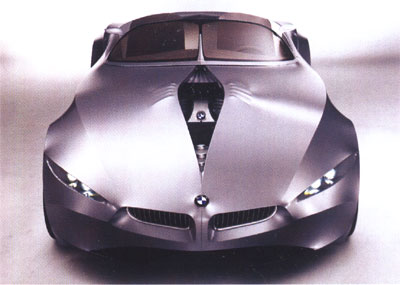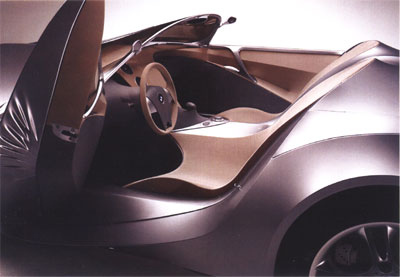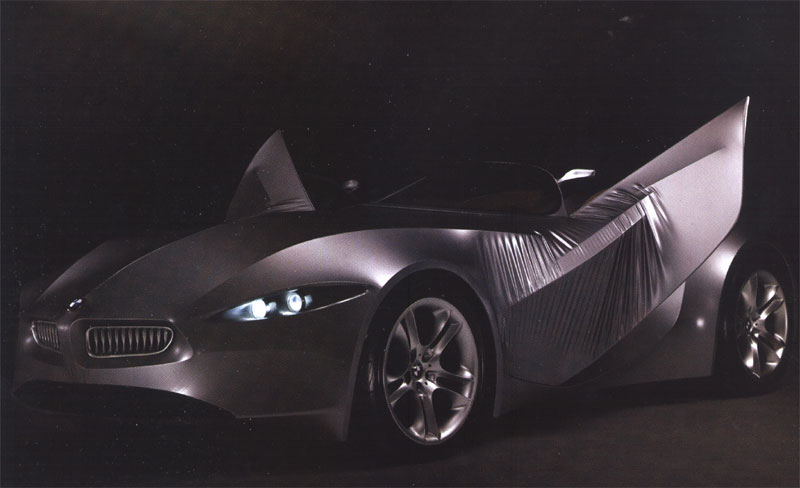BMW's new Material Car Gina

Light Fantastic - BMW's GINA
Skin and bones have worked well for Homo sapiens for millennia, so why not clothe a car's frame in skin-like fabric? The brightest brains in design at BMW put their thinking caps on.
When BMW designers and engineers pondered how they would design a car for the first time if they were starting in the 21st century and not re-using concepts from the 19th, the result was somewhat surprising, intriguing and potentially industry-leading.Some of the questions revolved around 'what ifs'.
What if the car of tomorrow doesn't need a stamped metal body shell? What if the body shell can reconfigure its silhouette on the move? What if the seats can close around each individual driver to give them maximum comfort and maximum protection?
Some of these questions spoke to the heart of car making.
If you don't need to build expensive presses to stamp out body panels unique to each model of car, can you build a wider variety of models to better suit the customers?
If you can reshape the body on the move, what effect does that have on the amount of energy needed to propel the vehicle, its traveling range or its ultimate performance?
Stamped metal exterior panels alone don't dictate the level of safety a vehicle can offer occupants, so if a space frame can do the job as well, if not better, as in race cars, why shouldn't flexible textile body replace steel or aluminum?
Traditionally, car makers expose customers to radical new ideas via the time honored Motor Show Concept Car. Not this time.
 The BMW GINA Light Visionary Model is a lot more than just your everyday concept car (GINA stands for Geometry and Functions in 'N' Adaptations - N meaning 'infinite').
The BMW GINA Light Visionary Model is a lot more than just your everyday concept car (GINA stands for Geometry and Functions in 'N' Adaptations - N meaning 'infinite').In an industry where new concepts invariably turn out to be rehashes of old ideas, GINA engenders some excitement about things that go beyond future styling, power train and packaging developments. The GINA Light Visionary Model utilises fabric to clothe a structure that, as well as being able to change its shape when required, also dispenses with many of the shut lines and panel joints that bisect the traditional car and detract from the purity of its looks.
GINA is based on a two-seat roadster format but there, as far as regular body structures are concerned is where it ends. There is no front apron, no bonnet and no boot lid, while conventional side panels, doors and wheel arches disappear into a homogenous four-piece whole.
The outer skin of the body is made of flexible, highly durable and extremely expansion-resistant fabric stretched over a structural metal framework.
The material is hybrid fabric with a stabilizing mesh netting support and an outer layer that is both water-repellent and resistant to high and low temperatures. Functioning, in some ways, like the skin on our bodies, it has normal hinged doors, but the leading edges flow into the front mudguards without any sign of a seam. Instead, the fabric skin wrinkles as the door opens and smoothes as it is closed. The bonnet over the engine compartment is even more intriguing as it virtually peels aside like skin on a ripe fruit to expose the mechanical innards.
Attending to aerodynamics is something GINA does well. At the rear, the profile of the car changes as speeds rise to increase down force, then resumes its original shape when coming to rest. The BMW grille opens and closes to control the cooling air to the engine while the rocker panels contort into various shapes depending on aerodynamic dictates. The headlights remain half-closed until switched on, at which point they peer from under sinister-looking eyelids, while the tail-lights are concealed beneath the fabric covering and only become visible through the translucent fabric when needed.
Inside, functional elements are kept to an absolute minimum, while the car remembers the driver and passenger's contours on seats that don't really look like seats until occupied. Then they reshape to maximise comfort and safety by altering the cushion profiles and raising the headrests. At the same time, the steering wheel and instrument panel also move into the correct place, all controlled by a transducer that stores information on optimal positions.
There is one thing that will be familiar to BMW owners - GINA's engine is started or stopped by pushing a button.
There was never a more organic car than the GINA Light Visionary Model. And there will most likely never be anything quite like it on the road - although some of the seemingly outlandish ideas the project has presented could one day be found on the production line; a production line that would be changed beyond recognition due to the new systems required to build a car such as this.
Comments:
Although this is a very interesting concept, how safe is it?
Maybe this brings us that little bit closer to thinking outside the box when it comes to cars, who knows maybe they will invent a rubber car, that could illuminate damage and accidents for good!

MORE
Copyright © 2001 - Female.com.au, a Trillion.com Company - All rights reserved. 6-8 East Concourse, Beaumaris, Vic 3193, Australia.



